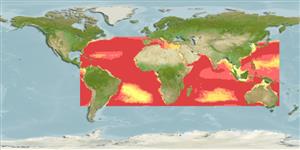Actinopterygii (ray-finned fishes) >
Aulopiformes (Grinners) >
Paralepididae (Barracudinas)
Etymology: Lestidium: Related to Greek, lestes = thief + Greek, ops = appearance (Ref. 45335). More on author: Borodin.
Environment / Climate / Range
Ecology
Marine; bathypelagic; depth range 50 - 1270 m (Ref. 86942). Deep-water, preferred ?; 46°N - 37°S, 84°W - 155°E
Widely distributed in tropical and subtropical waters of the three major oceans.
Size / Weight / Age
Maturity: Lm ? range ? - ? cm
Max length : 25.0 cm TL male/unsexed; (Ref. 4056)
Oceanic species (Ref. 26340) occurring from the surface (young) to about 1,000 m depth (Ref. 4473).
Life cycle and mating behavior
Maturity | Reproduction | Spawning | Eggs | Fecundity | Larvae
Post, A., 1990. Paralepididae. p. 373-384. In J.C. Quero, J.C. Hureau, C. Karrer, A. Post and L. Saldanha (eds.) Check-list of the fishes of the eastern tropical Atlantic (CLOFETA). JNICT, Lisbon; SEI, Paris; and UNESCO, Paris. Vol. 1. (Ref. 4473)
IUCN Red List Status (Ref. 115185)
CITES (Ref. 94142)
Not Evaluated
Threat to humans
Harmless
Human uses
Fisheries: of no interest
More information
ReferencesAquacultureAquaculture profileStrainsGeneticsAllele frequenciesHeritabilityDiseasesProcessingMass conversion
Tools
Special reports
Download XML
Internet sources
